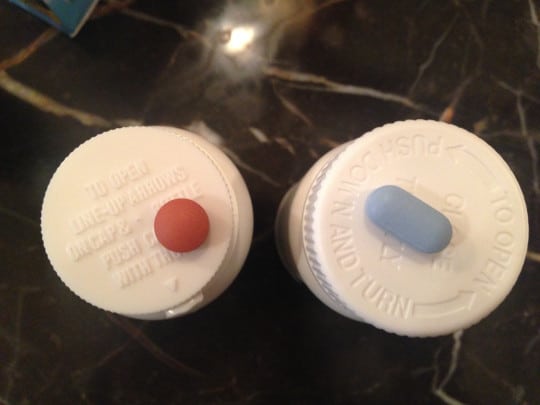Thankfully, it was nothing harmful or that dangerous… but I committed a medical mistake on myself last Saturday.
I tweaked my lower back last Wednesday – something that, thankfully, isn't a chronic problem (but I did just turn 40). It got progressively more painful over the next few days, so I went to an urgent care clinic on Saturday.
I was given a prescription for a muscle relaxant and was told I could continue taking Ibuprofen. Saturday afternoon, I took the muscle relaxant… and got incredibly sleepy almost immediately…
Sunday morning, I went to go take more Ibuprofen… and discovered that I had been taking Ibuprofen PM during the day Saturday… and had taken some before taking the prescription medication.
Oops. The Ibuprofen PM has a sleep aid in it.
I took the muscle relaxant Sunday afternoon… not incredibly sleepy. So, I guess it WAS the Ibuprofen PM.
Dr. Deming and the Lean approach teach us to blame the system, not the individual when something goes wrong.
In this case, I was the system. I have nobody to blame but myself. I know I should have read the front labels, but I was in pain and both bottles were on the countertop, so I only saw them from the top… and I grabbed the wrong one. I'm human. Mistakes like this happen.
But, still, here is the countermeasure I am taking…
The two bottles, the regular Ibuprofen and Ibuprofen PM look the same on top, even though they have very different labels. The pills look very different and, if I was taking Ibuprofen regularly, I might have already learned that the nighttime formula was blue. The labels on the front of the bottle are very different, of course, but I missed the “PM.'


OK, so now I know the blue pill is the PM formula. But, still, I decided to mark the top of the bottle as a preventive countermeasure for the future:

You might think there's a risk of putting the wrong cap on the wrong bottle… but they are different and wouldn't fit each other.
I think I'll be avoiding this mistake again.
Note that my countermeasure did NOT include putting up a warning or caution sign in my bathroom.
Now I need to think of good countermeasures for not hurting my back again!
The yellow / blue color coding is used pretty regularly to indicate if cold medications are daytime (yellow) or nighttime (blue), but this standard isn't always followed, as Eric Willeke said:
@MarkGraban did you get the yellow pills for nighttime congestion like I did? Switching off-brands killed performance ;)
Please scroll down (or click) to post a comment. Connect with me on LinkedIn.
Let’s work together to build a culture of continuous improvement and psychological safety. If you're a leader looking to create lasting change—not just projects—I help organizations:
- Engage people at all levels in sustainable improvement
- Shift from fear of mistakes to learning from them
- Apply Lean thinking in practical, people-centered ways
Interested in coaching or a keynote talk? Let’s start a conversation.










Thankfully so, many hospitals had made stride in preventing medication errors, but it used to be a serious risk factor to patients. Good point that you considered yourself “the system” as many people never look inwards for the cause of failure.
I don’t know if we can say the problem of medication errors is fully behind us, even with the efforts out there (things like bar coding, while helpful, but not 100% effective).
Part of the “system” I was in that day included being in a lot of pain. Led to bad judgment.
It makes me wonder how many nurses come to work even though they have back or leg pain… Does their judgment get clouded by being really sore or painful, especially with 12-hour shifts?
Mark: Great post…having worked in patient safety for the last 15 plus years,it is amazing to me why healthcare has not implemented more human factors concepts into preventing medical errors. I used to joke that dollar stores had barcode scanners for dollar items yet many
hospitals had not implemented the same technology. Hope your back feels better. Thanks.
Mark,
Ever since a high-diving accident in my “invincible youth”, I’ve had to watch my back. Some helps have been: firm mattress, zero sag, strong lumbar support, pillow under the knees to relieve that stress. Some on-mat slow back exercises which you can Google to get the details, AND, scrupulous attention to lifting and twisting. Yoga is also very helpful. Have not had an incident for many years now and I’m 76 and going pretty strong on my rural land.
One other issue, most pain relievers are not good for the body. Ibuprofen is one of the worst. Studies in integrative medicine show some nasty side effects for long time use. Just sayin’.
Be well!!
Thanks for your advice and concern, everyone. My back is pretty much back to 100% now… no more ibuprofen. I think it was just a function of time and not straining it again.
I got good advice from @Kevin_Meyer on Twitter about back strengthening exercises, yoga, etc. I might look into that as a good long term countermeasure.